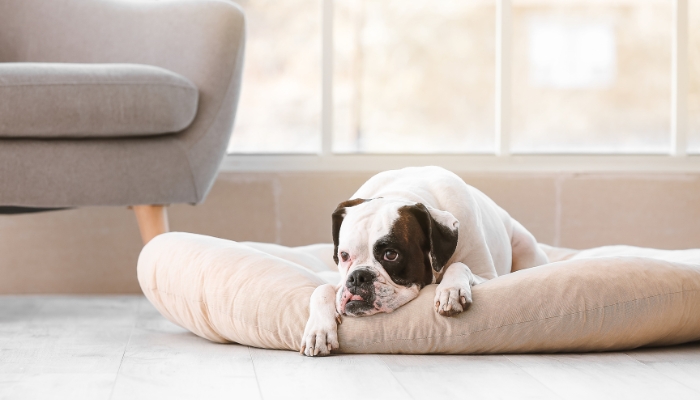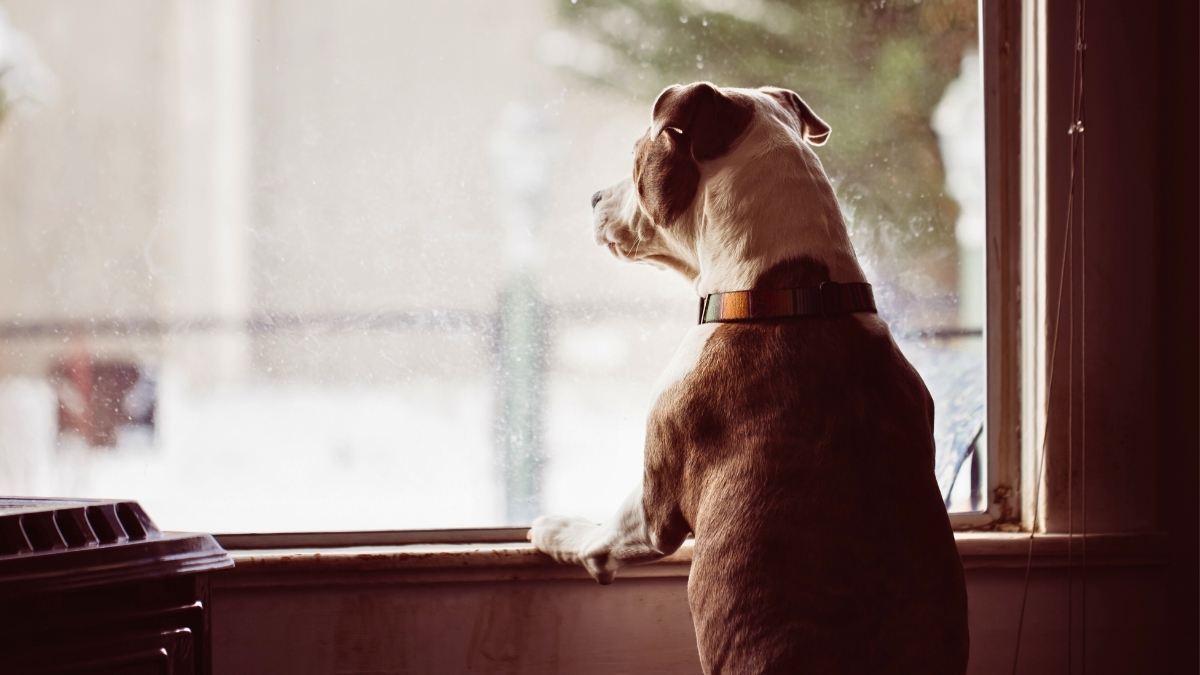When you leave your dog home alone, there are mistakes you might make that can make the experience more difficult for both of you.
In this article, I want to show you 8 common mistakes you should avoid to minimize your dog’s stress and keep them happy while you’re away.
If you know what they are, you’ll better understand the needs of your canine companion and how you can meet them even when you’re out.
Let’s start with the first one.
1: Don’t Leave Your Dog With Too Much Pent-Up Energy
It’s crucial that you spend some time exercising your dog.
Before you leave the house, make sure to take them for a good walk or have a play session. This not only allows them to expend energy but also strengthens the bond between you two.
A tired dog tends to be calm and relaxed, which increases the likelihood that they’ll just snuggle up and sleep while you’re gone.
Additionally, good exercise before leaving them alone helps them better handle separation anxiety and reduces the possibility of destructive behaviors.
I know it’s often complicated due to our lifestyles, but a simple walk can make a big difference.
2: Make Sure to Leave Them Water and a Room With Controlled Temperature
Before heading out, make sure your dog has everything they need to be comfortable.
This includes leaving enough fresh water and ensuring a pleasant temperature in the room where they will be.
Dogs can’t adjust the home’s temperature, so it’s crucial to maintain an environment that is neither too hot nor too cold.
In summer, turn on the air conditioning or a fan to provide a refreshing breeze. And in winter, heating should maintain a minimum temperature in the house.
And if you’re worried about the bills, don’t worry: you can just climate-control the main room where your dog will spend their time.
This way, you ensure their comfort and well-being without incurring excessive costs.
3: Set Up a Surveillance Camera
I’ll be very clear: installing a surveillance camera at home is one of the best decisions you can make to keep your dog safe when you’re not there.
It’s not only a really cheap tool, but it’s also simple to install and manage. Just place the camera in a strategic location, connect it to your Wi-Fi, and you’re set.
This way you can see what your dog does, how they behave alone, and if they are experiencing any problems.
You can also set up alerts to get a notification every time there’s a noise at home.
This way, you can react quickly if there’s a problem with your dog. But if you’ve done well with your dog, you’ll see them sleeping peacefully while waiting for your return.
4: Don’t Make a Big Deal Out of Leaving
A long and emotional goodbye will only make your dog feel that something important is happening, and this can increase their anxiety.
I want you to think about something for a moment.
When you leave, you know what time you’ll return, but your dog doesn’t know when you will. In fact, they don’t even know if you will return at all!
I know it sounds exaggerated, but your dog doesn’t know anything about your life when you leave the house. So, instead of a dramatic farewell, opt for a brief and calm one.
Just make sure they have everything they need, say goodbye calmly, and exit through the door.
And a trick: if you feel a strong need to show affection, do it a while before you leave.
Thus, by the time you leave, your dog will already be calmer and more relaxed. At these times, less is more.
5: Don’t Leave Anything Dangerous Within Their Reach
Your dog’s safety should be your main priority when you leave them alone at home. Before you leave, make sure all dangerous objects are out of their reach.
This includes medicines, foods that are not suitable for dogs, cleaning products, and any small object they could swallow.
And if your dog is particularly clever, secure the trash in a bin they can’t open.
Also, be careful with electrical cords, especially if you have a puppy or if your dog tends to chew when they’re anxious. Make sure to cover them or keep them out of reach.
By eliminating these risks, you significantly reduce the chances of your dog having an accident while you’re away.
6: Leave Them Some Puzzle Toys
Leaving your dog alone at home doesn’t mean their day has to be boring. Puzzle toys are tremendously useful tools for keeping your dog stimulated and occupied.
For example, a toy like the Kong, which can be filled with treats, not only provides entertainment but also challenges their mind.
Also, consider using a snuffle mat or hiding treats around the house.
These activities will make your dog use their sense of smell intensively, searching for the surprises you’ve left.
These types of games help improve their cognitive function and better manage separation anxiety, and this is especially important if your dog tends to get nervous during your absence.
7: Reduce Stress Factors
Reducing stress factors at home is crucial to ensure your dog stays calm while you’re away.
Things as simple as traffic noise or even the voices of people on the street can make them feel anxious.
An easy solution is to close the curtains and windows. This not only softens the noise but also dims the room a bit, creating a more relaxing atmosphere.
And if there’s something specific that you know makes them nervous, such as certain appliance noises or the doorbell, try to turn them off or adjust them before leaving.
By making these small adjustments, you are making it easier for your dog to have a more relaxed and stress-free alone time.
8: Don’t Leave Them Alone for Too Long
Remember that your dog should not be left alone at home for too long.
Although circumstances sometimes require it, it’s vital to understand that dogs are social creatures that need interaction and regular stimulation.
But if you need to know a rough estimate of the time you can leave them alone, you should know that the most important point for knowing how many hours a dog can be alone at home is their bladder.
The hours they can go without relieving themselves should mark the limit.
And to give you an idea of how much time we’re talking about, I’m going to divide the information into the 3 stages a dog goes through.
- When we talk about puppies, the hours they can go without relieving themselves match their number of months. If they are 3 months old, it should be 3 hours, and if they are 5 months old, the maximum time should be 5 hours.
- When the dog is an adult, they should not exceed 8 hours, but it’s advisable not to be more than 6 hours.
- And if it’s about dogs over 8 years old, depending on the breed and their health status, this interval is between 2 and 6 hours.
These figures are indicative, as each dog is different. Depending on their habits, breed, and health status, these hours may vary.

How to Teach a Dog to Be Alone at Home Step by Step
Teaching your dog to be alone at home is a gradual process that requires patience and consistency.
Start with very short outings, between 3 and 5 minutes.
During these brief periods, leave something they like, such as their favorite toy or a snack, to associate your absence with something positive.
Carry out these mini outings several times a day and, upon returning, it’s important to greet them with caresses and calm words to reinforce that relaxed behavior.
Your absence and your return should be synonymous with calm.
Gradually increase the duration of your outings to 10, 20, and then 30 minutes, observing how they adapt to being alone.
If you use a surveillance camera, you can monitor their behavior and make sure they feel safe and calm.
But if you notice signs of anxiety or stress, it’s important to step back in the time you leave and increase the activities that keep them entertained and relaxed.
This method not only helps them get used to being alone but also fosters a positive association with your absence.

Leaving your dog alone at home requires careful preparation and an understanding of their needs.
By avoiding these common mistakes and applying the step-by-step guide to teach your dog to be comfortable alone, you can ensure their happiness and safety.
Remember, a well-prepared environment and a calm approach to departures can make a significant difference in how your dog perceives being alone.
